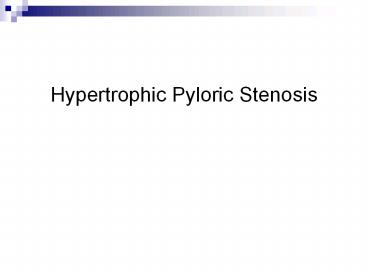Hypertrophic Pyloric Stenosis - PowerPoint PPT Presentation
1 / 13
Title:
Hypertrophic Pyloric Stenosis
Description:
Hypertrophic Pyloric Stenosis History The history of what we now refer to as infantile hypertrophic pyloric stenosis dates back to the early 1700s. – PowerPoint PPT presentation
Number of Views:204
Avg rating:3.0/5.0
Title: Hypertrophic Pyloric Stenosis
1
- Hypertrophic Pyloric Stenosis
2
History
- The history of what we now refer to as infantile
hypertrophic pyloric stenosis dates back to the
early 1700s. - Blair described an infant with postmortem
findings consistent with hypertrophic pyloric
stenosis in 1717.
3
Epidemiology
- Infantile hypertrophic pyloric stenosis (IHPS) is
the most common cause of gastric outlet
obstruction in infants. - The prevalence of IHPS ranges from 1.5 to 4.0 per
1000 live births in Caucasian infants but is less
prevalent in African-American and Asian children. - Reports have suggested that the incidence is
increasing. - It is well known that it is more common in boys
than girls, with a ratio of approximately 21 to
51. - The occurrence of IHPS has been associated with
several variables including both environmental
and familial factors. - IHPS is now thought to be caused by a mechanism
other than a developmental defect.
4
Anatomy
- The gross appearance of the pylorus in IHPS is
that of an enlarged,pale muscle mass usually
measuring 2 to 2.5 cm in length and 1 to 1.5 cm
in diameter.
5
Etiology
- The etiology of IHPS has eluded investigators for
several decades and no definitive causative
factors have been identified. - Both genetic and environmental factors seem to
play a role in the pathophysiology. - Another focus has been on alterations in
relaxation of the pyloric muscle. - As new technology and concepts have
evolved,additional associations that involve IHPS
and gastrointestinal peptides, growth factors,
neurotrophins, changes in neural development, and
nitric oxide have been described.
6
Diagnosis
- Nonbilious projectile vomiting.
- Visible peristaltic waves in the left upper part
of the abdomen. - Diagnosis can be made in 75 of infants with IHPS
by careful physical examination of the upper part
of the abdomen.you can palpate an enlarged
pylorus. - US(ultrasound) has become not only the most
common initial imaging technique for the
diagnosis of IHPS but also the standard for
diagnosing IHPS. - Hypochloremic?Hypokalemic?Metabolic alkalosis.
7
(No Transcript)
8
Treatment
- Minimal Laparotomy (Open) Technique
9
Treatment
- Laparoscopic Procedure
- 1 2
3
10
Treatment(postoperative management )
- In the majority of infants, feeding can be
started within 4 hours after the surgical
procedure. - Infants with hematemesis from gastritis may
benefit by delaying feeding for an additional 6
to 12 hours after the procedure.
11
Postpyloromyotomy Feeding Schedule
For very small infants, the starting feeding
volume may be reduced to 15 mL and the schedule
stopped at volumes of 60 to 75 mL, which provide
an adequate calorie supply.
12
Complications
- Complications after pyloromyotomy should be
minimal if performed by experienced surgeons. - Perforation (In a large series of infants
undergoing open pyloromyotomy, the incidence of
perforation was 2.3). - Wound-related complications occurred in 1.
13
- Thank you































